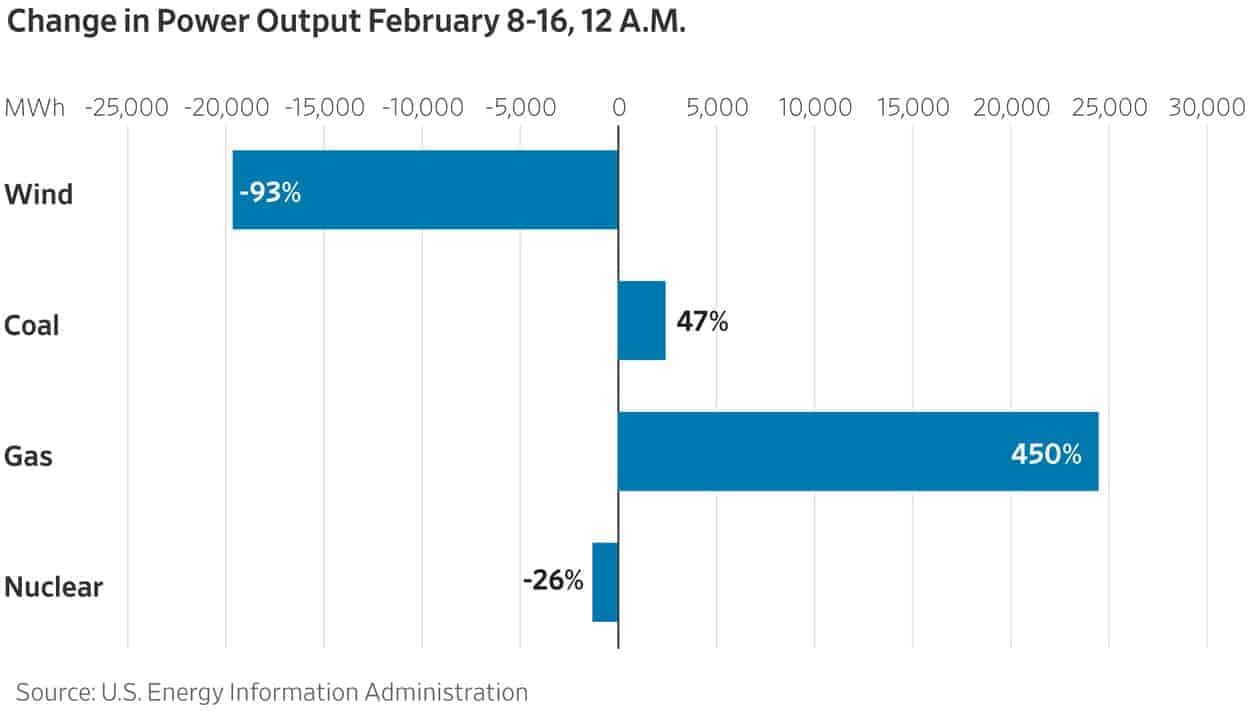Wall Street Journal Editorial Board on Texas Wind Power
While millions of Texans remain without power for a third day, the wind industry and its advocates are spinning a fable that gas, coal, and nuclear plants—not their frozen turbines—are to blame. PolitiFact proclaims “Natural gas, not wind turbines, main driver of Texas power shortage.” Climate-change conformity is hard for the media to resist, but we don’t mind. So here are the facts to cut through the spin.
Texas energy regulators were already warning of rolling blackouts late last week as temperatures in western Texas plunged into the 20s, causing wind turbines to freeze. Natural gas and coal-fired plants ramped up to cover the wind power shortfall as demand for electricity increased with falling temperatures.
Some readers have questioned our reporting Wednesday (“The Political Making of a Texas Power Outage”) that wind’s share of electricity generation in Texas plunged to 8% from 42%. How can that be, they wonder, when the Electric Reliability Council of Texas (Ercot) has reported that it counts on wind to meet only 10% of its winter capacity.
Ercot’s disclosure is slippery. Start with the term “capacity,” which means potential maximum output. This is different than actual power generation. Texas has a total winter capacity of about 83,000 megawatts (MW) including all power sources. Total power demand and generation, however, at their peak are usually only around 57,000 MW. Regulators build slack into the system.
Texas has about 30,000 MW of wind capacity, but winds aren’t constant or predictable. Winds this past month have generated between about 600 and 22,500 MW. Regulators don’t count on wind to provide much more than 10% or so of the grid’s total capacity since they can’t command turbines to increase power like they can coal and gas plants.
Wind turbines at times this month have generated more than half of the Texas power generation, though this is only about a quarter of the system’s power capacity. Last week wind generation plunged as demand surged. Fossil-fuel generation increased and covered the supply gap. Thus between the mornings of Feb. 7 and Feb. 11, wind as a share of the state’s electricity fell to 8% from 42%, according to the Energy Information Administration (EIA).
Gas-fired plants produced 43,800 MW of power Sunday night and coal plants chipped in 10,800 MW—about two to three times what they usually generate at their peak on any given winter day—after wind power had largely vanished. In other words, gas and coal plants held up in the frosty conditions far better than wind turbines did.
It wasn’t until temperatures plunged into the single digits early Monday morning that some conventional power plants including nuclear started to have problems, which was the same time that demand surged for heating. Gas plants also ran low on fuel as pipelines froze and more was diverted for heating.
“It appears that a lot of the generation that has gone offline today has been primarily due to issues on the natural gas system,” Electric Reliability Council of Texas senior director Dan Woodfin said Tuesday. The wind industry and its friends are citing this statement as exoneration. But note he used the word “today.” Most wind power had already dropped offline last week.
Gas generation fell by about one-third between late Sunday night and Tuesday, but even then was running two to three times higher than usual before the Arctic blast. Gas power nearly made up for the shortfall in wind, though it wasn’t enough to cover surging demand.
Between 12 a.m. on Feb. 8 and Feb. 16, wind power plunged 93% while coal increased 47% and gas 450%, according to the EIA. Yet the renewable industry and its media mouthpieces are tarring gas, coal, and nuclear because they didn’t operate at 100% of their expected potential during the Arctic blast even though wind turbines failed nearly 100%.

The policy point here is that an electricity grid that depends increasingly on subsidized but unreliable wind and solar needs baseload power to weather surges in demand. Natural gas is crucial but it also isn’t as reliable as nuclear and coal power.
Politicians and regulators don’t want to admit this because they have been taking nuclear and coal plants offline to please the lords of climate change. But the public pays the price when blackouts occur because climate obeisance has made the grid too fragile. We’ve warned about this for years, and here we are.
The simple truth is that so called “Green Energy” is not ready for prime time. It has been pushed by Government through grants and subsidies. The power shortages in California and now in Texas is just a glaring result of what happens when Government meddles in the free market system. Democrats actually think they can do better than the free… Read more »
There is an ancient legal term and phrase that originated in Roman law and indicates that suspects are often identified by “cui bono.” That is, who benefits from the shutdown of the XL Pipeline? The answer is obvious. Its the ChiComs who will now have all of that cheap and plentiful Canadian energy delivered to them. It was the first… Read more »
Read the comments at a blog and it said that the electric market in TX is unregulated. That means federal subsidies über alles for private firms and whether or not it works in real the world is not a consideration. Good feelz don’t turn on the lights and power up anything and it’s all fun and games until people start… Read more »